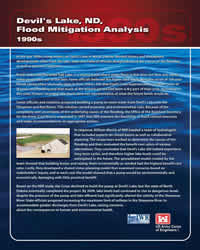 In the late 1990s, rising waters on Devil’s Lake in North Dakota flooded homes and threatened developments miles from the lake. State and Federal officials disagreed about the causes of the flooding as well as potential solutions.
In the late 1990s, rising waters on Devil’s Lake in North Dakota flooded homes and threatened developments miles from the lake. State and Federal officials disagreed about the causes of the flooding as well as potential solutions.
Devil’s Lake, like the Great Salt Lake, is a closed basin where water flows in but does not flow out; rather, water evaporates out of the lake. Some officials believed the higher lake levels were the result of 100-year floods taking place unusually close in time. Others felt that Devil’s Lake experienced long-term cycles of dryness and flooding and that much of the historic period had been a dry part of that cycle. According to this view, historic recorded lake levels were not representative of what the future levels would be.
Some officials and residents proposed building a pump to move water from Devil’s Lake into the Sheyenne and Red Rivers. This solution carried economic and environmental risks. Because of the complexity and uncertainty of the underlying causes of the flooding, the Office of the Assistant Secretary for the Army (Civil Works) requested in 1997 that IWR examine the feasibility of flood control measures and make recommendations on appropriate actions.
In response, William Werick of IWR headed a team of hydrologists that included experts on closed basins as well as collaborative planning. The researchers worked to determine the causes of the flooding and then evaluated the benefit-cost ratios of various alternatives. They concluded that Devil’s Lake did indeed experience long-term cycles, and therefore higher lake levels could be anticipated in the future. The spreadsheet model created by the team showed that building levees and raising them incrementally as needed had the highest benefit-cost ratio. Lastly, they developed a shared vision planning model that examined scenarios based on stakeholders’ inputs, and in each case the model showed that a pump would be environmentally and economically damaging with little practical benefit.
Based on the IWR study, the Corps declined to build the pump at Devil’s Lake, but the state of North Dakota eventually completed the project. By 2009, lake levels had continued to rise to dangerous levels despite the presence of the pump and lake effluent had significantly altered the salinity of the Sheyenne River. State officials proposed increasing the maximum limit of sulfates in the Sheyenne River to accommodate greater discharges from Devil’s Lake, raising concerns about the consequences to human and environmental health.
Learn more: